
The EZ-Use Kitchen
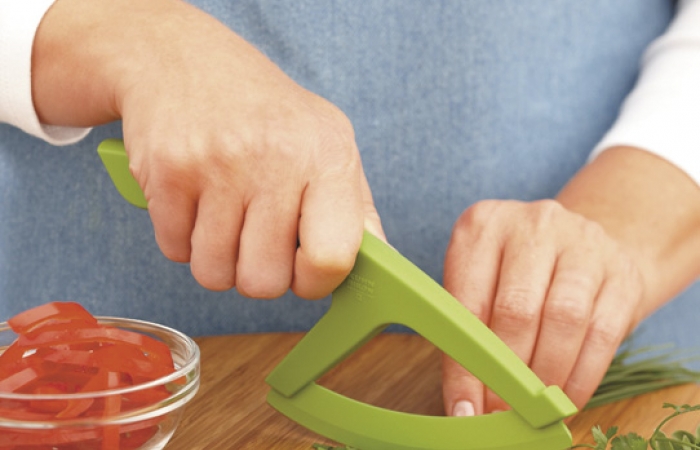
Mainstream appliances are becoming more accessible every day
You don’t have to do a total renovation of your kitchen to make your lifestyle more accessible. From storage solutions to preparing meals, minor changes can improve the functionality of a kitchen for someone with muscle weakness.
Kitchen designers and houseware manufacturers are incorporating universal design elements into their work. People who have disabilities have more choices than ever when building, remodeling, upgrading or simply buying a new kitchen product.
Jacqueline Dobson is the founder and senior designer at Solutions for Accessibility in Massachusetts. Dobson began her career more than 20 years ago as an occupational therapist. While she was working at the Boston Center for Independent Living as the program manager for the Adaptive Equipment Service, she discovered that people with disabilities were limited “not necessarily from their disability, but from the limitations in the environments.”
Dobson spent hours hunting for products that would improve the lives of her patients and frequently had to adapt mainstream products to fit their needs. But in the past few years, she’s seen an explosion of options on the market — and the Internet has made locating these products easier for everyone.
Dobson says she never would have imagined that one day her clients could buy: self-stirring pots that can sauté, sear, braise, boil or simmer while automatically stirring ingredients; motion-activated soap dispensers that dispense soap with a wave of the hand (Simple Human); motorized wall cabinets that lower to the front edge of the countertop (Granberg Interior AB); or a blender that cooks soup (Cuisinart).
Universal design is a hot topic
“We all need convenience and access in the kitchen. The space should be beautiful — not a space that is beautiful for a person with a disability, but a space that is beautiful for anyone,” says Mary Jo Peterson, a universal design expert and president of Mary Jo Peterson Inc., Design Consultants in Connecticut.
Peterson is a teacher and speaker for the National Kitchen and Bath Association (NKBA), as well as the author of Universal Kitchen and Bathroom Planning (McGraw-Hill Professional Publishing, 1998) and co-author of Gracious Spaces (McGraw-Hill Professional Publishing, 1999).
“We are moving toward universal design. It’s very different than it was five years ago. Now, builders want to do it and do it right. Ten years ago, they hadn’t even heard of it,” says Peterson.
The design industry is re-evaluating its best design practices with an eye on the needs of a large and aging population. Professionals are adopting universal design, aging-in-place, ergonomic and easy-living concepts. All of this translates into mainstream products and home design that work well for people at every stage of their lives and with a variety of physical needs.
“With baby boomers approaching retirement age, it has become increasingly important for builders and remodelers to furnish homes with appliances and controls that are easily accessible for all, without sacrificing aesthetics,” says Terri Connett, senior manager of contract marketing and design for the Whirlpool Corp. The company has more than 150 ADA-compliant appliances that are easier for people with limited mobility to use.
ADA features include handles, buttons and graphics that are located on the front of the appliance, positioned closer to the user and labeled in type that is 48 percent larger for easier visibility.
Appliance in a drawer
Drawers are great accommodations for wheelchair users, and dishwashers and microwaves have started to incorporate that feature.
Drawer dishwashers, such as those made by Fisher & Paykel Appliances, eliminate a loading step. Rather than opening the dishwasher door and then sliding out the rack, the drawer is the rack. A single-drawer unit can be used by smaller households, or drawers can be stacked to handle more dishes.
A microwave-in-drawer can be installed under the counter, in an island or under a cooktop. Not only is the microwave mounted lower, but it saves counter space and may be safer than conventional microwaves. The Sharp (KB-6524P line) drawer microwave can be opened two ways — by the handle or by simply touching the control panel. It features an easy-to-read angled control pane, a “warm” setting that lets you heat syrup for pancakes, and a “beverage center” that warms coffee or heats water.
Easier-access fridges and ovens
Without buying a thing, you can make your current refrigerator more accessible by placing frequently used items in the produce drawers.
Side-by-side refrigerators (one side fridge, one side freezer) typically are recommended for people who use wheelchairs, but French door refrigerators are becoming “enormously popular,” says Peterson. Like a side-by-side, they feature dual doors on top, but each door opens to the refrigerator. A pull-out freezer drawer is on the bottom.
For even better access, Samsung’s RF4287 is a 28-cubic-foot French-door fridge with an additional drawer above the freezer at counter height (boasting a “kid friendly” EZ-Open handle). Four temperature options mean the “Flexzone” drawer can be used as a fridge, a freezer or even a wine cooler.
Side-opening ovens are hard to find but are a good choice for cooks in wheelchairs. Fagor America makes a 24-inch convection oven with a side door that can open from the left or right. American Range’s 30-inch residential wall oven has two French doors that open for easier access.
Cabinetry
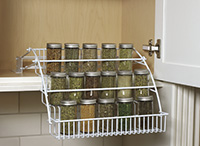
One design trend is eliminating kitchen wall cabinets so the space is more open, with lots of windows and natural light. Peterson says base cabinets are being used in new ways.
Homeowners are storing dishes in lower cabinets and there are accessories that keep the dishes from sliding in the drawers — some even have racks allowing you to carry them to the table.
Dobson encourages those with upper cabinets to try products like Rev-A-Shelf’s Pull-Down Shelving System, which brings hard-to-reach items out of the cabinet and down 10 inches. Rev-A-Shelf also offers a large collection of organization solutions that can increase storage or simply make it easier to retrieve items.
Add a lazy Susan to a hard-to-reach corner cabinet. Never hunt for a frying pan lid again — instead, use a cookware organizer.
These accessories (which also are available from a variety of other manufacturers) can be installed in existing cabinetry.
Smart appliances
Some products do more, like the GE SmartDispense line. Store up to 47 ounces of liquid detergent in the dishwasher, which then automatically dispenses the correct amount for each load. (The GE SmartDispense line also includes washing machines.)
Jenn-Air’s Culinary Center convection oven takes the guesswork out of cooking and has hundreds of preprogrammed menus. Use the large 7-inch touchscreen to select the type of pan you’re using, the food item, its weight and desired doneness, and then the oven will determine how long and at what temperature to cook the dish.
Appliances that take care of themselves help keep the kitchen running smoothly. Peterson says that nowadays, repair people can hold their phones up to some oven doors to learn what needs to be fixed.
Some products are so sophisticated that they send a message to the manufacturer when something is amiss. Perhaps the oven temperature needs readjusting — the oven notifies the manufacturer.
“Nothing is the same anymore because of where tech is taking us,” says Peterson.
Barbara’s picks for fun and functional kitchen gear
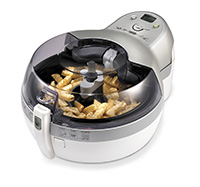
It’s no secret I don’t like to cook. I’m always looking for ways to make meal preparation, cooking, and cleanup easier.
One of my favorite sources for what’s new, useful and unique is Hammacher Schlemmer. They sell the Best Electric Wine Opener which can open up to 40 bottles when fully charged. It’s a great gift for people who love wine or love to entertain, or both.
I never fry food, but I was impressed with their Healthiest Deep Fryer (pictured at right). With only one tablespoon of oil, you can “fry” up to two pounds of food. Plus the self-contained, covered fryer doesn’t make a mess.
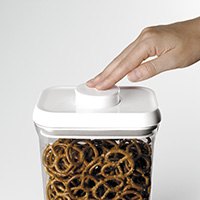
OXO Good Grips POP Containers (pictured at right) are see-through storage containers with a simple-to-use lid. Just push a button and the lid pops up. I store doggie treats in mine.
Browsing in a specialty kitchen store, I discovered Kuhn Rikon. The Switzerland-based company makes the Kulu Herb & Vegetable Knife. The curved knife with a high carbon Japanese steel blade is easy to grip and uses a rocking motion to chop — perfect for someone with weak hands. Another product that sits on my counter is their Ratchet Mill. It is the easiest way I’ve found to grind coarse ground pepper.
I like potato chips, but don’t need the calories. Mastrad’s fat-free chip maker is amazing. The chips are cooked on a silicone surface in the microwave. Kids love making the chips and eating them too. The company also makes a microwavable rice and grain cooker (pictured at right) that is fast and less work than stove-top cooking.
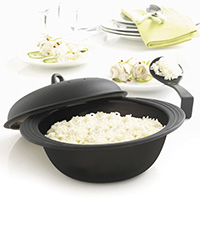
If you’re trying to eat more fruit, the Oster My Blend Blender is a smoothie maker that mixes ingredients in a sports bottle that then can be removed and used for drinking — no pouring. I like strawberries, raspberries, pineapple mixed with yogurt and ice cubes.
My go-to appliance is the slow cooker. The Crock-Pot Cook & Carry Programmable Slow Cooker comes in stainless steel with a lid that stays on for transporting.
Leftovers can be stored in close & clip containers by the German company Emsa. The see-through container, extra-long freshness feature and easy-to-open snap lids make these my pick for best container.
The company also offers nonslip trays that enable you to more safely transport items from kitchen to table on your lap. The trays can handle a tilt of up to 15 percent without tipping over their contents.
Explore the choices
Before you replace an old appliance or even buy a new kitchen gadget, explore the options. The plethora of kitchen products gives everyone more choices. Talk to designers, compare features, search the Internet and read the kitchen magazines to learn about the latest trends. Every day, manufacturers are unveiling products that just might make your kitchen more accessible.
The Twardowskis are a husband-and-wife writing team from Mandeville, La., who are frequent contributors to Quest. Barbara has Charcot-Marie-Tooth disease and uses a power wheelchair for mobility.
MDA Resource Center: We’re Here For You
Our trained specialists are here to provide one-on-one support for every part of your journey. Send a message below or call us at 1-833-ASK-MDA1 (1-833-275-6321). If you live outside the U.S., we may be able to connect you to muscular dystrophy groups in your area, but MDA programs are only available in the U.S.
Request Information